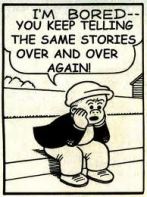5 Pro Drumming Tips and Tricks
An Interview with Thomas Lang and Benny Greb – The technical masters share their secrets
Thomas Lang (foreground) raised the bar for drummers everywhere with his two hit DVDs, Creative Control and Creative Coordination And Advanced Foot Technique. His solo performances are dazzling and he is in constant demand as a session player, in addition to working as both a producer and writer in LA.
Benny Greb’s (background) The Language Of Drumming: A System For Musical Expression DVD is a showcase for his ability to make music with the drums. When Rhythm spoke to Benny he had just returned from a huge clinic tour of Asia, spreading his philosophy across the globe.
Both Benny and Thomas possess the enviable ability to turn their hands and feet to a huge range of musical styles, from jazz and fusion to rock and pop and make it all look so easy in the process. So, when Rhythm got face-to-face with these two masters of the kit, they wanted to find out the secrets of their technique and get some handy tips and tricks that you can apply to your drumming.
 Tip 1: Set up correctly
Tip 1: Set up correctly
What’s the most common mistake people make when setting up their drums?
Thomas: “To set the drums up for the viewer so it looks cool from the front rather than for yourself. I know a lot of young drummers make that mistake. Number two would be to set the drums up so that the bass drum is facing the audience straight on, rather than being off to the right if you are a right-handed drummer, because the bass drum is not the centre of the drumset.
“We, as drummers, often make the mistake of thinking pattern-oriented, which means we focus on what we do instead of how we do it.” Benny Greb
“Number three is to try to make the drumset perfectly symmetrical. Another is to sit too low or too high, or to set up the cymbals too far away from the player so you have to play with your arm completely stretched – I see that a lot.
“Whatever you do with your body mechanically has to be within a spherical space. It’s not a straight plane, you are moving within a spherical space and your set-up has to reflect that, so whatever is higher on the drumset has to be closer to you.”
Benny: “I would say it’s that they don’t really set it up, bit by bit, in relation to how they sit and to their body, but they set up their kit then sit behind it and see whether it feels right.”
Now try this: kit set-up
Benny: “What creates great results is to take your stool, adjust it so it is cool for you, which normally means there is more than a 90° angle between your legs and your spine and between your upper legs and lower legs. Then you set up the snare drum so it is comfortable, then a bass drum where the foot really sits, then a hi-hat where the foot really sits, and so on.
“If you let students do this, it really results in a very natural set-up.”
 Next: Tip 2: Get a grip
Next: Tip 2: Get a grip
Benny, you play matched grip. Do you prefer a French timpani grip or a German grip?
Benny: “Being patriotic I like the German grip! I think there is this conspiracy on the internet where someone always pays some people to say that this or this is the best grip and blah blah blah. The thing is that you can’t do everything with one grip, it’s not possible, so you need these different grips to do different things. You can’t do any accents with finger technique, you need the wrist, you need the Moeller technique.
“I think I am generally in a more German position but it’s a little weird with me – it’s not out of the teaching rulebook, what I do. My right hand tends to be more French and my left hand tends to be more German grip. It’s not very symmetrical.”
Thomas, you’ve played with both matched and traditional grips. What would you say are their comparative strengths?
Thomas: “I think the strength of traditional is that it’s an asymmetrical grip and it affects the way you think. The asymmetry of the grip lends itself to asymmetrical thinking and therefore playing, a bit like playing the guitar where the left hand is on the fretboard and doing something completely independent from the right hand which is strumming, but together the two hands produce one sound.
“I look at playing traditional grip the same way where the two hands use two completely different techniques – one hand from underneath the stick, the right hand from on top so there is a push-pull dynamic in your upper body. Matched grip is more modern, it’s more powerful, it’s more balanced. You have better reach with matched grip. It causes fewer injuries. Traditional grip causes a lot of bruises, abrasions, chafing, all sorts of issues. Of course you get blisters with both grips but less surface and skin injuries with matched grip. It lends itself to a more ambidextrous style with open-handed playing, which would be awkward using traditional grip.”
“Rule number one: for speed you must compromise volume. There is no other way, you can’t play ultra-fast and ultra-loud at the same time.” Thomas Lang
What’s the one piece of advice you would give someone looking to improve their playing with their hands?
Benny: “Have a catalogue of parameters that you go through focussing on while you’re playing and adjust your technique according to that list. Some people say it’s boring to play a paradiddle every day for an hour and they are totally right. It’s absolutely boring to play a paradiddle but it’s not boring if you listen to the sound that it makes and try to get it consistent.
“If you take time for one of these parameters, just the sound, does it sound the same? Do you have to play on the same spot? Do you find it hard to play on the same spot? How does it sound if you don’t play on the same spot? Is that a different sound that you want to cultivate, to have in your repertoire? Do you always make rim shots when you try to accent? Can you accent without doing rim shots, focussing on dynamics only?
“The other thing is how much less muscle motion can you use to get the same effect? How is it, time-wise? Do you breathe enough? Are you able to focus long enough or do you dream away? What do you think about? Things like that. If you do all these things then it’s the technique that I talk about it and it’s much more than just moving your muscles.”
Thomas: “I can think of a thousand things! One thing would be to practise unison strokes, playing both hands at the same time, not alternating.”
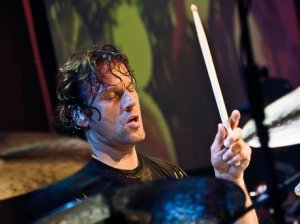 Now try this: grip
Now try this: grip
Thomas: “Make sure that your left hand and your right hand are equally strong by playing fast unison strokes in different patterns, in different cycles; groups of three, groups of five, seven, two 16ths and one eighth note, but with both hands at the same time.
“That way you make sure your hands are equally strong and you can concentrate on either the right or the left for timing and precision while you are playing.”
Tip 3: Quicken your kick
Are there any shortcuts for fast double-kick playing or is it just a question of putting in the practice?
Benny: “Yes and no. There is this thing, practice makes perfect, which is not right. Perfect practice makes perfect. You can practise in the wrong way forever without getting any results. We sometimes try harder at things – ‘I have to play more, I have to practise harder, I have to practise longer.’ Sometimes it takes us too long to think, ‘Okay, it’s not practising longer, I should try it differently.’
“With a car it’s what baggage can you drop off to make it run faster? If you can’t equip the car with a better motor and you want to go faster, you have to drop weight. In your motion and your technique, it’s not about equipping yourself with more fancy stuff, it’s getting rid of all the excess stuff you don’t need. Then the car runs faster.”
Thomas: “There are certain ways to make it a little easier using pedals with super-high tension, long board pedals with a very low footboard angle, trigger microphones with electronics… It’s a bit of a joke because double bass drums have to be played with aggression. This is an aspect of aggressive music and without volume there is no aggression.
“I’ve seen many bands that perform and, when you are listening to the drums from behind the riser, it is very quiet. There is a complete lack of power and to me this kind of music has to be played with ‘oomph’ and some serious muscle. If it doesn’t have that and it’s all just triggered then it has no substance.
“Rule number one: for speed you must compromise volume. There is no other way, you can’t play ultra-fast and ultra-loud at the same time. I make a compromise by playing loud and when it starts getting weak and wimpy I stop because I can play faster but at a certain speed you lose volume.
“There are certain ways to make it easier but to achieve powerful single-stroke rolls or double-stroke rolls on the bass drum requires nothing but practice. A few years of intense, focussed bass drum practice, but you get results.
“If you stick to it you will be able to execute powerful and beefy double and single strokes at a fast tempo upwards of 200bpm that can be played on any acoustic drum and work in any playing situation without trigger mics.”
Tip 4: Improve your technique
At what point should technique enter the picture in your journey as a player?
Thomas: “Technique was always a major aspect from day one from my first drum lesson when I was five. My teacher talked about technique but because it was from day one it never registered with me as anything special or daunting. It was just there. This is what you need in order to execute these things.
“After 10 years of playing I started to tweak my own techniques and combine techniques and really understand for myself why certain techniques exist, how to employ them correctly in order to make playing easier, or how to switch between techniques to produce different sounds or feels.
“I try to stay out of the groove’s way. A groove is that repetitive cycle that creates the magic. As soon as you play a fill or change it, it kind of ruins it.” Thomas Lang
“That came later in my development. Technique as part of learning was there from the beginning.”
 Benny: “There is expression first, then maybe later you find out you need more technique to express what you want to express. I think this is the best order. Sometimes people think, ‘Oh, wouldn’t it have been great to learn all the technique and then get started?’ No, that would be horrible! It’s so important to play first and experience music and have fun.
Benny: “There is expression first, then maybe later you find out you need more technique to express what you want to express. I think this is the best order. Sometimes people think, ‘Oh, wouldn’t it have been great to learn all the technique and then get started?’ No, that would be horrible! It’s so important to play first and experience music and have fun.
“Technique, as I define it, is stuff that you always try to take care of – sound, time, focus. I very seldom do things like, ‘Let’s get on the Moeller technique again,’ or ‘Let’s check out the different grips again and what we can optimise there,’ but every once in a while I do it with focus and learn something.
Do you think in terms of technique when coming up with fills?
Thomas: “Never, no. I don’t think about fills and I try to avoid fills. I only play them if I am prompted or the producer demands it. When I work for other writers or producers I have no desire to be flash, add fills or any stuff that is unnecessary or could interrupt the groove or take away from the feel of the song or be in the way of a singer. I just play the song.”It’s great but it’s not something that’s on my list every day because it’s simply not the most important thing.”
“I try to stay out of the groove’s way. A groove is a repetitive cycle that only works after a certain amount of repetitions. It’s that cycle that comes around that creates the magic. As soon as you play a fill or change the cycle it kind of ruins it. It’s like having a beautiful brick wall that’s made out of all identical bricks and suddenly you start adding half sizes and a blue brick, two red ones, then two quarter-sized yellow ones.
“Okay, this is now a mess. Where is the beautiful red brick wall? Unless the music asks for it and you want a lot of colourful playing and a lot of variations, in most session situations that is not required and not asked for.”
Benny: “With fills you try to make them as groovy as the grooves, like groove variations rather than ‘fills’, like to fill some beats in. With Steve Gadd, you don’t even know that he’s playing a fill. It’s a different groove in bar four or something.
“You have to have one consistent thing and that is the quarter-note pulse. If you focus on that you will have that flow to whatever you play.” Benny Greb
“Sometimes drummers change everything, they change body posture, stop breathing for one bar, change their technique, focus more on the pattern. They change everything but they expect that the time feel shouldn’t change. That doesn’t make any sense.
“You have to have one consistent thing and it should be the quarter-note pulse. If you focus on that then the chances are quite high that you will have that flow to whatever you play, which is a mental technique.”
When you are doing a solo performance, do you think about what techniques you can incorporate in your playing?
Benny: “I don’t structure my solos in terms of displaying technique, not at all. Yuck, that feels ugly – I would feel dirty doing that. If I have a good day, and everyone has good and bad days and sometimes I have to think more than I would like to, but if I have a good day I don’t think at all, not only about technique but I think about nothing.
“I just play and I see what happens and I let myself be guided by mistakes that I do and try to repeat them so they become a composition.”
 Thomas: “Everything I do in a solo context is displaying techniques. Everybody is taking the whole solo thing so seriously, as if that was part of my musical identity, which it isn’t. They are only drum shows for drummers. All I’m doing is displaying techniques and noodling around and being flash and spectacular. It’s really only a display of technique, often only for technique’s sake, not for music’s sake.
Thomas: “Everything I do in a solo context is displaying techniques. Everybody is taking the whole solo thing so seriously, as if that was part of my musical identity, which it isn’t. They are only drum shows for drummers. All I’m doing is displaying techniques and noodling around and being flash and spectacular. It’s really only a display of technique, often only for technique’s sake, not for music’s sake.
“There is hardly anything that I play in a clinic context that is non-technical. If I am a viewer at a clinic I’m not going to see somebody play a beat. If I want that I’ll go to a concert and I’ll watch the guy play with a band in a context that is less demanding of something spectacular and where the performer would feel more at ease to play something a little more subtle, more musical.”
Do you have time for practising?
Benny: “No one has time for anything. You can take time, so I take time for practising. Sometimes I don’t practise daily, but as I said, perfect practice makes perfect so I try to make my practice as good and as focused as possible.
“I live very centrally in Hamburg so I don’t have the possibility of having a drumset here. I have a little studio/practice room and I drive there and take a couple of hours whenever I can. I have a pad here obviously but I see myself being more inspired when I sit at a real drumset.
“When I’m on tour I tend to use the pad more but I try to play the drums if possible.”
Thomas: “No, I never practise. I haven’t practised for many years. I’m not proud of it. Actually I’m fully ashamed of it and I wish I could but I have a life besides being a musician.
“I work a lot, not only as a drummer but as a writer and producer. I have a lot of session work and it’s very time-consuming and unfortunately there is no time to practise. I like to practise and I wish I could practise more. I am always working on making more time to practise.
“I hope once my kids are in school I can make some more time to finally get back into practising.”
 Tip 5: Keep better time
Tip 5: Keep better time
Do you have any good techniques to improve time-keeping?
Benny: “You have to be aware of the quarter-note pulse. I have this exercise on my DVD where there is a quarter note pulse ‘singing’, with this click sound you make a ‘chit’ sound. It’s just an exercise where you do this ‘chit’ sound with clapping or improvising which really shows you, do you think time-oriented or pattern-oriented, which makes a big difference.
“We, as drummers, often make the mistake of thinking pattern-oriented, which means we focus on what we do instead of how we do it, and sometimes even why we do it. If we try to do a certain fill, we concentrate more on executing the fill how we want it instead of executing it, even if it comes out differently but having good time.
“In your motion and your technique, it’s not about equipping yourself with more fancy stuff, it’s getting rid of all Benny: “We as the excess stuff you don’t need.” Benny Greb
“Time, you could say, is a mathematical thing if you break it down, but groove and a good feel are an emotional thing, not a mathematical thing – and that needs a lot of sensitivity and a lot of focus and also some democracy in the band and some tension between the players.
“If I had to strip it down, what helped me the most in time-keeping would be this quarter-note ‘chit’ singing while improvising. It’s a great exercise. Whenever I have a timing problem, when I listen to a gig and some fill is kind of weird, I go back into the practice room, try it out and I sing the quarter-note to it. Then in the future it really sounds great.”
Thomas: “If you can remember tempo then you are less likely to speed up or slow down. That can be achieved by association and muscle memory. The best way to do it is to combine the two.
“Association, meaning you have a song in your mind. You know this Police song is at 115bpm or this Kings Of Leon tune is at 150bpm. You sing the song, it only takes you about five seconds to sing a chorus and pretty much nail a tempo. That’s association, then at the same time you have a muscle memory component.
“It’s necessary for every musician to be able to learn tempos by heart. If you ask me to play 72bpm, I can nail it. It’s a learned skill that anybody can do. It’s easy to nail 60bpm because everybody has a watch, but if you have 60bpm you always have the double-time and the half-time.”
In the great debate of technique versus musicality, is there any danger you can take the pursuit of technical excellence too far?
 Benny: “Technique should be a tool that you use for something. That’s why I love the Indian approach so much because first you have to learn the musical language of what you will express. You won’t play it with your instrument or your technique that will be relevant later but you have to do it with your voice, so you are just focussing on expression.
Benny: “Technique should be a tool that you use for something. That’s why I love the Indian approach so much because first you have to learn the musical language of what you will express. You won’t play it with your instrument or your technique that will be relevant later but you have to do it with your voice, so you are just focussing on expression.
“If you are then fit enough and know what you want to say as an artist then, after a year of that syllable talk stuff, you learn how to play your instrument. They’ve got the order right and this is what I try to do when I talk to people in clinics or when I still had students, I always tried to wait until they came up with something and said, ‘I want to play drum’n’bass,’ or ‘I want to play heavy metal double bass.’
“It’s always people who have no technique that say they don’t need technique to play the drums. Technique is a tool. Why not use the right tool?” Thomas Lang
“Then this was the chance for me to say, ‘You need this technique to get this sound,’ then they have a reason. Sometimes I see people who practise technique and then they have this monstrous tool that is very dangerous if used unwisely and then they run around: ‘Hmm, where can I use this?’
“If you go to a doctor that is very good at open heart surgery but you only have a cold and he cuts you open because he wants to prove to you how good he is, you wake up, ‘What the hell is this?’
“We, as drummers, need to have an ethical code like doctors that it’s good to do what’s necessary with technique and with our knowledge and not always good to do what you can do. This is important when we talk about technique.”
Thomas: “That argument is usually happening between people who have no technique, who don’t understand what the heck they are talking about. To say that technical music is not musical is saying that Mozart and Chopin are not musical, that Rachmaninov and Bach are not musical. This is ridiculous. Of course it is musical!
“Technique often makes music. If you listen to Vivaldi, this is super technical music. Zappa is not musical? Tony Williams isn’t musical? Steve Gadd? Dave Weckl? Stop being ridiculous, people, and wake up. ‘Technique has nothing to do with music’ – the argument is nonsense. You must stop arguing about this.
“It’s always people who have no technique that say they don’t need technique to play the drums. Technique is a tool. You use it for certain activities. You need a hammer to drive a nail into a wall. You need a circular saw to chop lumber. You can use the circular saw to get the nail out of the lumber but it’s not the right tool. You can use pliers for that. You can use a hammer to chop wood, it will take much longer and it won’t be a straight edge.
“Why not use the right tool? If you can acquire it, it will make playing easier and that’s all that technique is. If you have technique it will make playing easier for you. It won’t affect your musicality in a negative way.
“The more tools you have, the more reined works you can do, the more precise you are, the more creative you can be and the more efficient you can be in executing all your musical ideas.”
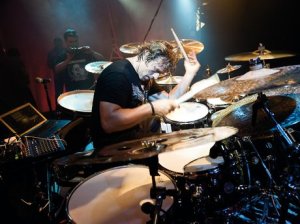 Now try this: timing
Now try this: timing
Thomas: “Learn five tempos in steps of 10s, for example 100bpm which means you are also able to play 50bpm and 200bpm. Do that in steps of 10, learn songs in each tempo, memorize the song and associate some muscle memory with the song you have in mind, meaning that you know you can only play a certain pattern with your right hand at a certain speed or the right hand can only play 16th notes at that speed using finger control.
“At a faster tempo you have to switch to Moeller strokes or Gladstone technique. You know what your physical comfort zones are at certain tempos and that narrows the tempo margin. That aspect in association with memorising a tune allows you to completely nail a tempo.
“This is a learned skill, all you have to do is put in the time, make an effort to learn some songs and just clock your favourite tunes. Get a metronome out. You probably don’t know how fast Back In Black is, so get a metronome out and clock it.
“If you like a song and have heard it a thousand times, you can feel the song without hearing it, you know what the tempo feels like, it’s internalised. All you need to do is know what that number is.”
Article written by David West (Rhythm)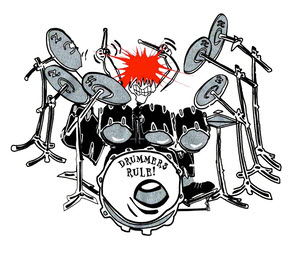
Brett Frederickson – DrummersRule! Drum Lessons
twitter : https://twitter.com/drummerbrett
facebook : https://www.facebook.com/drummersrule
google+ : https://www.google.com/+BrettFrederickson
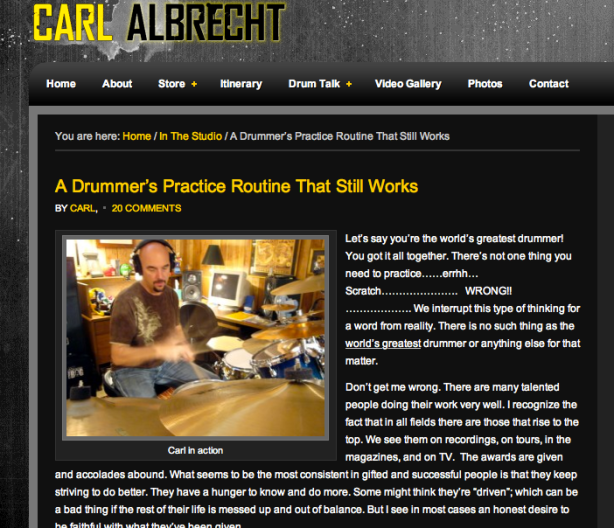
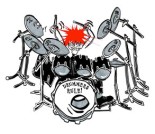
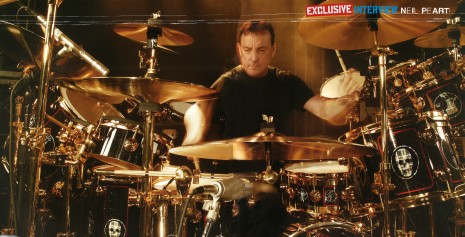 s to conquer even the purest of souls, the challenge of emerging unscathed is a feat comparable to mastering one-handed drum rolls – wearing a boxing glove.
s to conquer even the purest of souls, the challenge of emerging unscathed is a feat comparable to mastering one-handed drum rolls – wearing a boxing glove.
 e first recommendation. You can’t learn too much. I worked on samba for a long time just to learn Latin feels. I’ve never used it, but I understand it and I have fun with it. Timekeeping, too, no one can work too hard on that. Every drummer goes through the stage of playing a fill, getting excited and speeding up, or coming out of the fill and slowing down. Everyone goes through that and it gives you great insecurity – other musicians pick on you, producers pick on you. It’s very undermining because you think, ‘Well, the drummer’s first job is to keep time and I can’t keep time’. Something everyone should understand though is a) that everyone goes through that and b) it’s correctable. It takes the effort to practice and practice until you realise how to play your fills so they won’t speed up and until you get an innate sense of time.”
e first recommendation. You can’t learn too much. I worked on samba for a long time just to learn Latin feels. I’ve never used it, but I understand it and I have fun with it. Timekeeping, too, no one can work too hard on that. Every drummer goes through the stage of playing a fill, getting excited and speeding up, or coming out of the fill and slowing down. Everyone goes through that and it gives you great insecurity – other musicians pick on you, producers pick on you. It’s very undermining because you think, ‘Well, the drummer’s first job is to keep time and I can’t keep time’. Something everyone should understand though is a) that everyone goes through that and b) it’s correctable. It takes the effort to practice and practice until you realise how to play your fills so they won’t speed up and until you get an innate sense of time.”


 Next: Tip 2: Get a grip
Next: Tip 2: Get a grip







